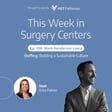
Mike Ferguson – Evaluating Ownership Options: Navigating Both Management Group and Hospital Ownership
Mike Ferguson, President of Horizon Solutions, joins us to conclude our three-part series on Evaluating Ownership Options for ASCs. As an expert in working with ASCs and OBLs, Mike sheds light on one of the more complex ownership models—when physician owners, a third-party management group, and hospital partners are all involved. In this episode, Mike shares practical strategies for navigating the challenges of balancing different priorities, fostering collaboration, and keeping all stakeholders aligned to ensure the success of the ASC.
In our news recap, we’ll cover ASCA’s comments for CMS on the 2025 proposed payment rule, California’s new Data Exchange Framework, where providers and payers are increasing their IT spending, and, of course, end the news segment with a positive story about Aaron James, a man from Arkansas who received a whole eye transplant.
Articles Mentioned:
- ASCA Advocates for Changes to CMS 2025 Proposed Payment Rule
- California’s data exchange framework proves government can do big things
- Providers and Payers Are Increasing Their Tech Spend — Where Are They Investing the Most?
- Man living ‘normal life’ after world-first eye transplant
Brought to you by HST Pathways.



















